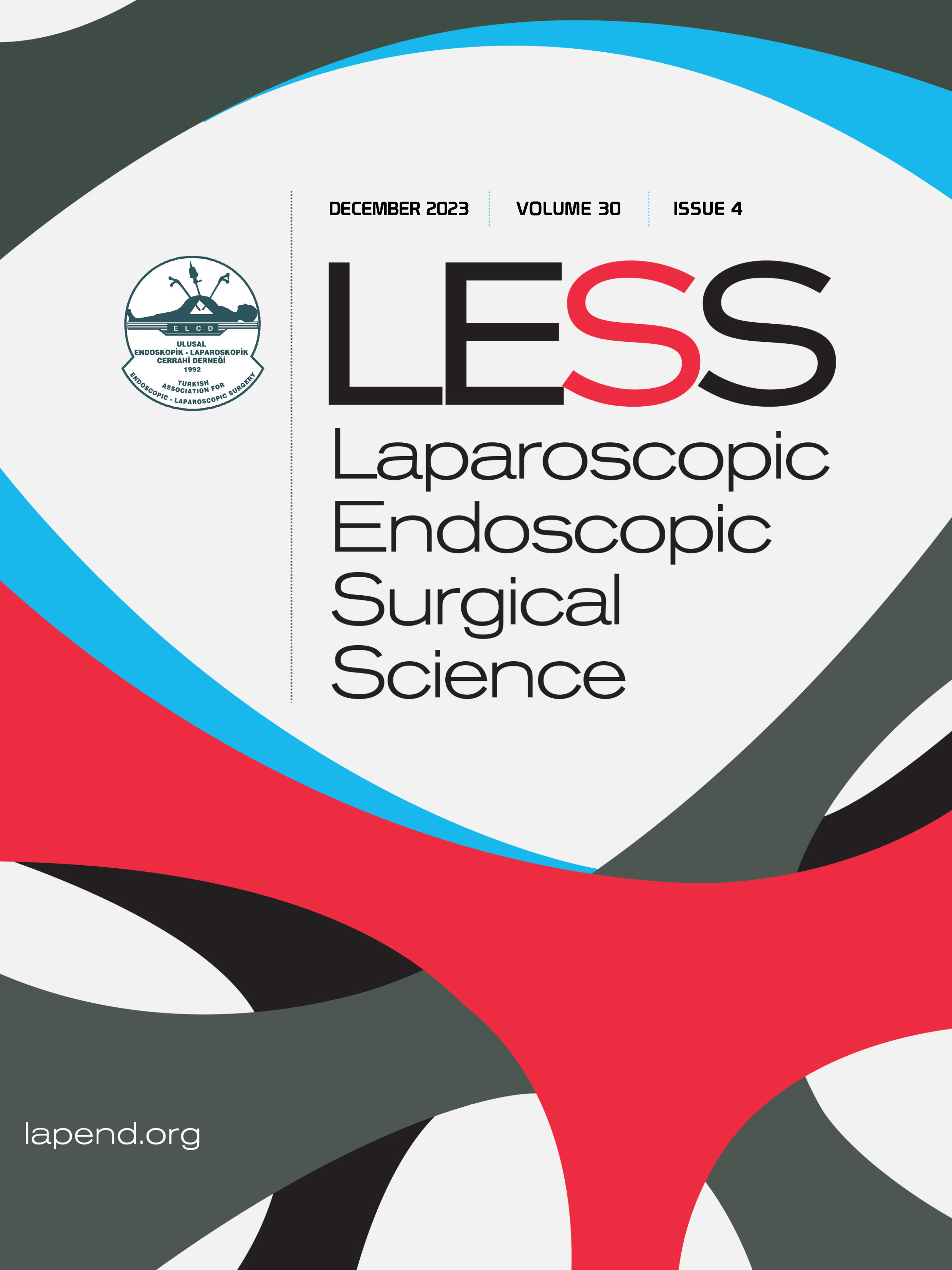Volume: 11 Issue: 3 - 2004
| TECHNICAL NOTE | |
| 1. | National Scientific Board Pages 101 - 102 Abstract | |
| LETTER TO THE EDITOR | |
| 2. | Letter to the Editor Page 103 Abstract | |
| RESEARCH ARTICLE | |
| 3. | Laparoscopic repair of recurrent inguinal hernias Fazıl Sağlam, Gıyasettin Keskin Pages 106 - 111 INTRODUCTION: The aim of this study is to review the recurrent inguinal hernia patients we operated on laparoscopically and were evaluated retrospectively. METHODS: We evaluated the results of the 48 recurrent inguinal hernia patients we operated on laparoscopically between September 1997 and March 2001. RESULTS: While 43 of all hernias were unilateral, there were contralateral primary hernias in 5 cases. Recurrences were medially next to the public tubercle in 32 patients (%66.6), through the internal ring in 14 patients (29.1%) and at the both sites in 2 patients (4.2%). Inferior epigastric vascular damage in 2 patients (4.2%), bleeding into the Retzius space in 1 (2.1%), transient lateral cutaneous femoral nerve damage manifested as lateral thigh paresthesia in 1 patient (2.1%) has occured intraoperativelly. Postoperative inguinoscrotal hematoma 1 patient (2.1%) and seroma (2.1%) has occured. We had to convert open technique in 1 patient (2.1%). Overall complication rates were 12.8%. Mean operating time was 56 minutes (range,20 to 110). Mean hospital stay was 1.2 days (range,1 to 3). Recurrence has occured in 1 patient (2.1%). DISCUSSION AND CONCLUSION: Laparoscopic prosthetic mesh repair can be used safely in the treatment of recurrent inguinal hernias with less complication and recurrence rate. |
| CASE REPORT | |
| 4. | Complication of the operative hysteroscopy: a case report Pelin Öcal, Nurhan Kahraman, Ismail Çepni, Sanlı Erkan Pages 112 - 115 The major factors having an impact on the success of endoscopic surgery are the experience of the surgeon and the quality of instruments and materials used. We present a case developed as a result of uterin perforation and a resectoscope's broken loop under the light of the literature. |
| 5. | Our experience of combined spinal-epidural anaesthesia for laparoscopic-assisted vaginal hysterectomy: a case report Nurten Kayacan, Gülbin Arıcı, Fatma Ertuğrul, Bilge Karslı Pages 116 - 120 We aimed to reveal our ecperience of combined spinal-epidural anaesthesia for laparoscopic-assisted vaginal hysterectomy in a case that presented with severe menometrorrhagia caused by myoma uteri and had an upper airway infection and look over regional anaesthesia in laparoscopic procedures. Midazolam 1 mg and meperidine 25 mg intravenously were given for premedication. The haemodynamic parameters such as systolic and diastolic blood pressure, heart rate and peripheral oxygen saturation were monitored. Combined spinal-epidural anaesthesia technique was performed through L3-4 interspinous space; first 15 mg 0.5% izobaric bupivacain was given intrathecally and then a 20 G epidural catheter was places in the epidural interspace. After 10 minutes, level of anaesthesia reached to T5-6 level and the operation was started. Arterial blood gas samples were obtained and analyses before and 10 minutes after pneumoperitoneum was constituted. Systolic and diastolic blood pressures, heart rate, SpO2 were recorded throughout the operation. The patient was placed in Trendelenburg position at 10 degrees and intraabdominal pressure was kept at 13 mmHg. The patient complained about right shoulder pain just after pneumoperitoneum was constituted. It was observed that shoulder pain was decreased by administration of intravenous midazolam 1 mg+ fentanyl 0.05 mg and disappeared after the release of pneumoperitoneum. Afterwards the operation none of the possible complications like hypotension, bradycardia, hypoxia and hypercapnia were seen. We conclude that regional anaesthesia techniques are safe and efficacious for short duration laparoscopic surgical procedures in the presence of experienced surgical team and close patient monitorization. |
| 6. | Intrathoracic knotting of guide-wire: videothoracoscopic treatment A. Kürşat Bozkurt, Lale Yüceyar, Ahmet Demirkaya, Tülay Samancı, Gökçe Şirin, Mete Burak Özdemir Pages 121 - 124 We present a case of an intrathoracic guide-wire extravasation and knotting in a 75 year old woman following catheter insertion for hemodialiysis. Intrathorasic extravasation caused right apical hemotoma and total pneumothorax. The guide-wire was removed with thoracoscopic approach. |
| RESEARCH ARTICLE | |
| 7. | The role of video-assisted thoracic surgery in the treatment of malignant pleural effusions S. Ibrahim Dinçer, Hasan Akın, Adalet Demir, Zeki Günlüoğlu, H. Volkan Kara, Atilla Gürses Pages 125 - 130 INTRODUCTION: Video-assisted thoracic surgery (VATS) which is used more often in the treatment of malignant pleural effusions (MPE) provide both diagnosis and treatment. This study evaluated the efficiency of VATS in diagnosis and tretament of MPE. METHODS: Between 1996-2002, 57 patients who were treated due to MPE in Yedikule Chest Surgery Center, 2nd Surgery Clinic were evaluated retrospectively. Thirty-one of the patients were male, and 26 female with a mean age of 55±12 (27-83). Thirty-six patients were treated with tube thoracostomy and pleurodesis was compared between tube thoracostomy and VATS groups. RESULTS: The most common etiology of MPE were lung cancer, malignant mesothelioma, breast cancer, and ovarian cancer in decreasing order. Eight out of 36 cases treated with tube thoracostomy had recurrence in 30 days. Whilst none of the 18 cases treated with VATS and pleurodesis had recurrence. Talc was given by way of tube thoracostomy in 23 patients and by VATS in 18. VATS pleodesis was succesful in 100% of patients but tube thoracostomy achieved 87% success rate (p>0.05). The tube drainage time of tube thoracostomy and VATS were 7.3 and 4.5 days respectively, and the difference was statistically significant (p<0.05). DISCUSSION AND CONCLUSION: VATS enables the physician to take multiple biopsies under direct vision for diagnosis, and also provides rapid decision about the treatment options. Besides VATS is more succesful than tube thoracoscopy although the difference is not statistically significant. |
| CASE REPORT | |
| 8. | Bronchogenic cyst removal with video assisted thoracoscopic surgery: report of two cases Gökhan Hacıibrahimoğlu, Levent Cansever, Ümit Aydoğmuş, Mehmet Ali Bedirhan Pages 131 - 135 Two cases with cystic lesions situated on posterior mediastinum underwent cystic extirpation by video assisted thoracoscopic surgery (VATS) following preoperative evaluations. Histopathological outcomes were interpreted as bronchogenic cyst. No postoperative or follow-up complication was observed. It is often necessary to confirm the diagnosis and to perform a therapeutic surgical resection for cystic lesions in the mediastinum. Although the conventional surgical approach is thoracotomy, we suggest that video assisted thoracoscopic surgery is more convenient in such resections rather than thoracotomy. |
| TECHNICAL NOTE | |
| 9. | Instructions to the Authors Pages 137 - 141 Abstract | |















